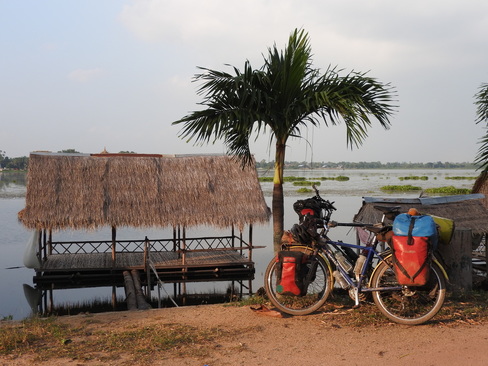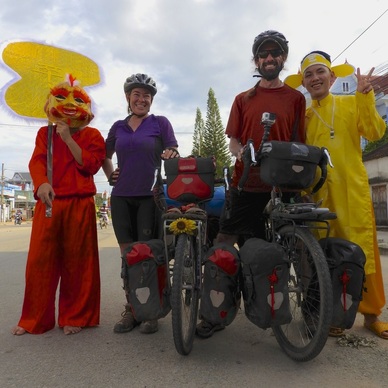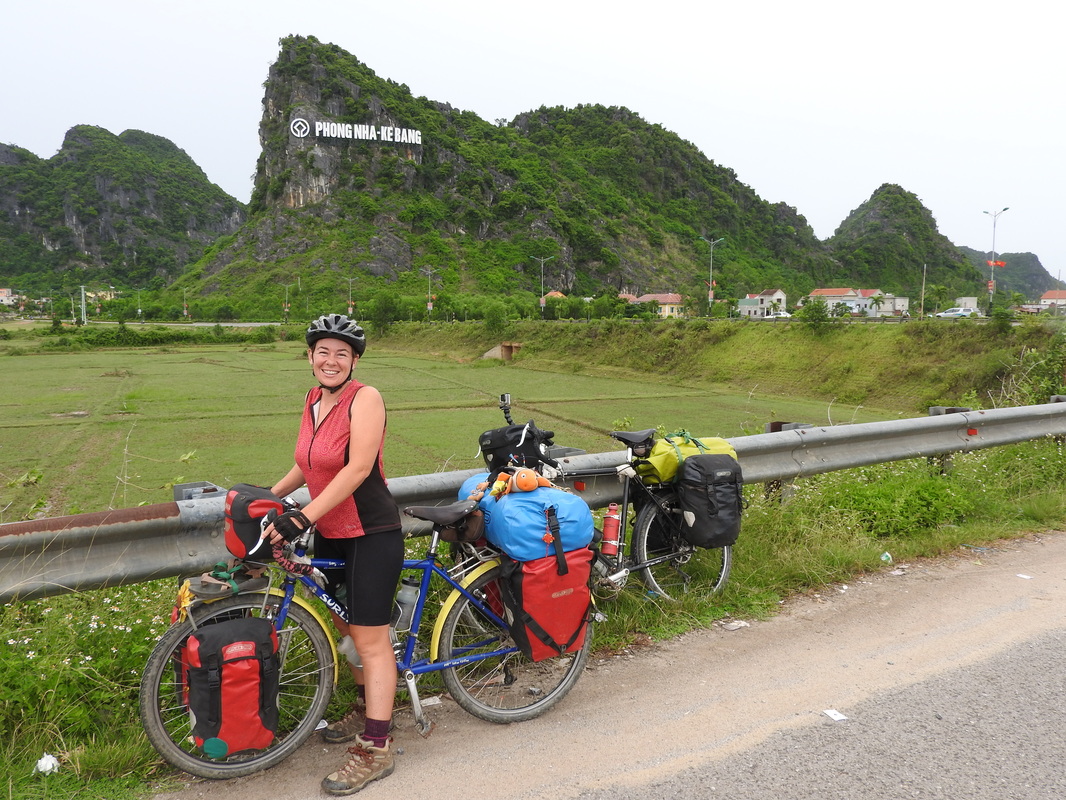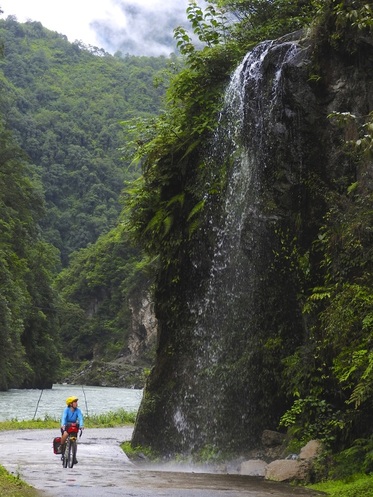
Ironically, by turning back, we discovered what we had been seeking but failing to find: a backroad path through small farming and canal communities that make up the heart of delta life. Unfortunately, that path soon dumped us back on the same type of busy road we had been trying to get off of. Of course, the highway was the most direct route in to the city and we had little time to spare before our Vietnam visas expired. We decided the 50 or so miles we endured was the most unpleasant stretch of road we have ever ridden, made even more stressful by the gradual widening of the crack and bulging of the tire. Yes, we could have taken transport, but at the time it seemed a bearable distance to ride versus the inevitable hassle of putting bikes on a bus.
Van built two new wheels for my bike no problem, and on the last possible day for us to leave the country without penalty, we cycled from HCMC to the border crossing at Moc Bai, thus completely rearranging our route through Cambodia as well. Originally, we had hoped to cross at the most southerly border checkpoint and travel along Cambodia's coast before exploring inland. Now we were headed to its capital city of Phnom Penh first, then turning south for the coast. We held a new appreciation for the simplicity of Cambodian visa procedures after dealing with the ridiculousness of visas in Vietnam. With indefinitely extendable visas issued on our arrival at the border, we crossed into only our seventh country in fifteen months of travel.
The following day we were taught an unforgettable lesson about Cambodian roads. In Vietnam, the traffic necessitated always taking the smallest road possible, which in Cambodia equates to the unpaved dirt tracks any time one leaves the main highway. It had rained quite hard the night before, so it was actually a mud track, but still rideable, at least initially. But in the rice fields beyond the village, the mud suddenly turned to thick sticky clay, rideable only for the short distance it took to completely fill up my fenders and jam up the wheels. Unable to move, I dismounted and tried to push my bike, but it wouldn't budge. I dug enough clay out of the fender to at least turn it around before it got stuck again. A bemused local woman working in a nearby rice field came over and told me in broken English that the way was no good and I had to turn around, which I had clearly already done. I agreed. She told me again. I agreed. She repeated herself, and I agreed again. This went on for a while. When the helpful woman finally felt she had informed me enough times not to keep going, she turned her attention to helping me dig out clay and push my bike a few feet at a time. Meanwhile, in keeping with the fact that I am always the tester of road conditions from my position in the front, Matt stood at a safe distance from the mud pit and watched the fun unfold.
You would think this defeat would be enough for us to return to the main road, but instead we took a different fork in the road that looked promisingly less muddy. It was all good until the track sloped downhill and simply disappeared underwater for as long as we could see. We resigned ourselves to following the highway in to Phnom Penh, thus learning that a main road in Cambodia is equivalent to a side road in Vietnam thanks to its much lower population density and less developed economy. Besides, the highway provided the entertainment of watching endless overloaded minivans and tuk tuks pass by, crowded to a degree we had not yet seen in Asia. The back hatches of the minivans were open, with luggage and bags extended beyond the bumper of the vehicle with ropes. People sat on the cargo with their feet dangling out the back, others sat among the things strapped to the roof. Apparently the road was exceptionally busy as people returned to Phnom Penh after spending a holiday with family in the countryside.
Vendors lined the road with snacks for the multitude of travelers. At one major intersection, we were beckoned to stop and buy crickets fried with chilies. I bought a portion as a courtesy for the photo opportunity, but of course we tried them as well. The flavor was generally undesirable, likely not from the cricket itself but from what I suspect was rancid oil it was cooked in. Conveniently, we amused the passengers hanging out the back of a van when we handed the baggie of crickets off to them with motions of distaste just as the vehicle slowly accelerated from the side of the road.
Before arriving in Cambodia, several people told us independently of each other that "Cambodia is chill." Arriving to Phnom Penh, Cambodia's "hectic" capital city, this certainly appeared to hold true. The pace of life, the traffic, the nature of the people were all quite mellow in comparison to HCMC. This chillness was most evident in visiting a few of the city's markets where we really had to work hard to get someone's attention while shopping around for a few items. Having recently taken care of a slew of travel errands in HCMC and no visa deadlines to constrain our itinerary, we had the leisure of exploring Phnom Penh more thoroughly than we normally do in large cities.
We made up for never visiting the Grand Palace in Bangkok by spending an afternoon at Cambodia's Royal Palace complex with temples of similar design, as are the other wats we have since seen in Phnom Penh and beyond. While the coronation hall and silver pagoda were memorably beautiful, we were most intrigued by an aged mural facing the courtyard and extending the length of all four barrier walls. Apparently it depicts the Indian epic of Ramayana with Cambodian adaptations.
Sadly, Cambodia's street food scene was also "chill", as in nearly nonexistent. After the vibrant selection in Vietnam that we ate almost exclusively from, we struggled to find equivalent restaurants that sufficiently filled the void. While the local markets had some food stalls in the spirit of street food, our biggest success was a place called MC Coffee that became our go-to breakfast. Iced coffee with sweetened condensed milk was served just as it was in Vietnam, but instead of fried egg banh mi sandwiches, we had the Khmer classic of strips of fried pork and omelette served over rice with a side of pickled veggies.
The night market was a fun scene even though the selection of food focused on skewers of over-processed meat that was deep-fried on demand. A square of inward facing food stands surrounded an area spread with woven mats and narrow walkways to access them. Large groups of friends and families sat in a circle on the mats, piles of shoes at the fringes. We did our part by sampling an Angry Birds mystery meat skewer and finally "getting around" to trying a duck fetus egg. Ok, I ate the boiled egg with a partially developed duck fetus inside while Matt documented. The flavor was fairly similar to a normal hard boiled egg, but obviously the variable consistency and textures were not. It's definitely one of those foods that looks way worse than it tastes though. And then there's the mental bias too.
No visit to Cambodia is complete without recognizing the gruesome and still too recent history of the Khmer Rouge's rise to power and the consequences of it that Cambodia is still dealing with today. We began our education of this element of the country at the Tuol Sleng Museum, also known as the Genocide Museum, and previously known as Security Prison S-21 to the Khmer Rouge. It has been preserved as the largest of many detention and torture centers that had the agenda of extracting false confessions of anti-revolutionary activity from those accused by the Pol Pot regime. It is a particularly sobering experience to walk through the very rooms where prisoners were locked down to metal bed frames in isolation, or shackled by the ankles to each other along a common metal bar, all with original equipment on display. It was also strange and somewhat telling to reflect on how easily the format of a standard school was converted into a prison. Rows upon rows of concrete rooms only required the additions of metal bars in the windows and barbed wire enclosing the outdoor hallways to make the repurposing complete.
Once the accused was sufficiently tortured to confess to their made-up crime, they were transported to a place now known as The Killing Fields of Choeung Ek for mass execution by crude and brutal methods. We paid our respects to this site as a stop on our first day cycling south out of Phnom Penh. A measured but articulate audio tour effectively sets a quiet respectful tone as visitors take in the mounds, holes, bone shards, and even tatters of clothing that all serve testament to the thousands of innocent Khmer who were killed here, from infants to elderly. A plot to maintain absolute control through absolute fear devised by a deranged and paranoid man, but a cunning man who first came to power by appealing to the impoverished and disenfranchised. The ranks of the Khmer Rouge swelled when rural Cambodia was at its most vulnerable, having been devastated by years of "secret bombing" by the good ol' US of A.
The influencing factors, the circumstances of instability, or any other context to set the terror of the Khmer Rouge in, does not make it seem any more intelligible. The best we can do is to honor the memory of the victims and respect the lessons of history with bringing the intention of peace into all aspects of our lives.
With the significance of these historical sites on our minds, we continued on and soon had no choice but to be absorbed in the joys of contemporary Cambodia again. We detoured a short distance to Tonle Bati, a scenic lake popular with Phnom Penh folks on the weekends. As such, stilted and thatched roofed wooden platforms extend along one side of the lake, each with an attendant who will bring you overpriced food from a nearby restaurant should you choose to relax the day away on their platform. Or, Matt and Casey style, you can rent the platform for $1 and make your own peanut butter and jelly sandwiches while watching orange-robed monks cruise by in a motorboat. With the sun low in the sky, we thought about how this would make an ideal spot to spend the night. The platform owner declined to give us permission, but it seemed that she offered her home instead. We weren't quite sure, so she called over a younger lady with some basic English and she offered her home as well. We didn't know what to do then, since it seemed rude not to go with the first lady who offered, but the younger girl became more insistent we should go with her.
We followed Dara back to her family's home and picked up her BFF Sokny, with more confident English, on the way. Their tall stilted house was quite new, but still very modest by Western standards, especially considering the lack of any substantial furniture and possessions inside. The heart of the home was actually underneath the house, where hammocks were strung up adjacent to large day bed bamboo platforms and an outdoor kitchen. We sat down there for a while to meet the rest of the family and a few curious neighbors, then the girls offered to take us to see Ta Prohm and Yeay Peau, both historical temples from the Angkorian era. Despite a soccer game wrapping up in the courtyard of the temple complex, the otherwise quiet and deserted grounds at dusk lent an eerie feel to exploring the site.
In keeping with all of our homestay experiences, it had to get confusing at some point. Sokny told us to order off the overpriced menu from the lake and she would bring us dinner from the restaurant. We weren't too keen on paying those prices, but she explained that we didn't have to pay, or could pay "as you wish." However, the family had not prepared enough food for us. Fair enough, we were very unexpected guests. Then Dara and she returned with the ingredients of what we ordered and cooked it for us, while we never saw the family eat. After a brief period of improvised socializing after dinner with the friendly family, Sokny politely informed us it was time for bed and they settled us in to the parents' bedroom, complete with a mosquito net and fan. We did need to deploy our camping air pads though as the woven mats provided weren't quite enough cushioning from the wooden floor.
Early to bed, early to rise holds true in Cambodia as well, so the family was already doing chores and yard work when we made an appearance at 6:00am the next morning. We were offered noodle soup and coffee, which we accepted, so the girls zoomed off to pick it up at the restaurant for us. Oh...Oh well. After we ate, we said our goodbyes and gave them enough money that would certainly cover whatever the ambiguous food expenses may have been.
Overall, it was an enjoyable experience that gave us a bit of insight into a Khmer rice farming family's daily existence in a Cambodian village. At least on the surface, it's not so different from rural life in other Southeast Asian countries. Kind of like Southeast Asian beer, the nuances of flavor may vary slightly, but at the end of the night, it's all same same, and not so different. That said, we were pleasantly surprised by a relative multitude of decent stouts available in Cambodia in addition to the usual lagers. This is a trend that other countries would do well to adopt!
Still on our way to the coast, we next stopped at Phnom Tamao Wildlife Rescue Center where various animals, many of them endangered species, have been confiscated from poachers or abusive owners. While we rode around the extensive grounds on our fully loaded bikes, we saw many animals we could only dream of being lucky enough to see in the wild, such as sun bears, a leopard, and a new favorite species of monkey called a pileated gibbon. Better still, we saw some that we did not even know existed, like the binturong, which Matt described as "a rat of unusual size." After observing Khmer group after Khmer group obnoxiously harassing the animals in their enclosures to get them to do something "exciting", we realized the scope of the challenge that organizations such as Wildlife Alliance face in this country. If these were people coming to see animals, supposedly with an awareness of why the animals were there, and THIS was how they chose to treat them...More frustrating still was the lack of supervision to ensure a truly peaceful existence for the animals. Perhaps they could charge locals a bit more than 50 cents and hire some visitor supervisory staff or mandatory guides. After all, the well-behaved foreigners had to pay ten times the local rate.
After the wildlife sanctuary, we had intentions of checking out a historical hilltop temple, but with the late hour of the day, we decided to push on to the town of Takeo. We settled in to the nicest hotel room we have ever paid $6 for, and went out to some food carts along the riverside. We shared a spicy green mango salad and gave the skewer thing another chance, but the grilled chicken wings were as meatless as they looked, just skin and flimsy bones. As we were finishing up, a downpour came out of nowhere and we took shelter under the tarp of another vendor along with some sociable Khmer guys who invited us to join their slightly soaked dinner featuring more beer than food. We enjoyed toast after toast of watery beer on ice until the rain abated enough to make it back to our room.
Once dried off, we took a several hour nap before awaking to an alarm at 2am. We had an important FaceTime meeting with a class of Coloradan high school seniors, but not just any high school seniors. Our sister-in-law, Lauren, teaches a leadership course and incorporated our journey into the preparatory curriculum for the students to design and actualize Capstone Projects. We were honored to have the Before It's Gone Journey be an example of "the ultimate Capstone Project" for the students, even if we don't always feel that way about it ourselves. The students had great questions that really made us reflect on our journey as well.





 RSS Feed
RSS Feed
